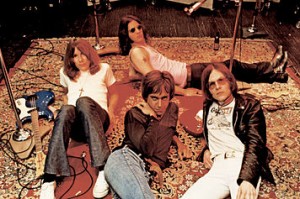July 17, 1946 – January 6, 2009

James Oldham raises a glass;
I grew up in High Wycombe, so I didn’t know much about rock’n’roll -the little I did know came courtesy of Thee Hypnotics (for those not acquainted think a hipper version of all those denim Sub Pop bands like Mudhoney).
Anyway, as far I could tell (the singer Jim Jones went out with my mate’s sister), they only liked two kinds of music – the kind made by the MC5 and the kind made by The Stooges. And I’ll always be grateful for them hooking me onto The Stooges.
Anyone who hears that band for the first time can’t fail to feel the same thrill. The fuzz, the howl, the danger, the melodies, the gleeful (I)dumbness(I) of it all are breathtaking. And for a white, middle class boy from the Home Counties, it was the authentic sound of juvenile delinquency – and it’s never stopped sounding like that ever since.
The reason for writing this of course is that on Tuesday January 6 Ron Asheton was found dead at his home in Ann Arbor – a tremendously sad moment, as he played on the triumvirate of incredible albums The Stooges released between 1969 and 1973 (as well as the forgettable aberration that was 2007’s ‘The Weirdness’) and was at the heart of the nihilistic sound that made them the greatest rock band of all time.
On the first two, their self-titled debut and 1970’s ‘Funhouse’ (my favourites by far), his brutally reductive guitar playing is the real headrush. It sounds like those brief moments of fuzz that Johnny Burnette’s guitarist Paul Burlison peppered his songs with amped up and strung out for eternity.
Probably because he started out as a bassist (that’s what he played when Iggy joined his band The Prime Movers in 1965 prior to the formation of The Stooges) and definitely because they were in a permanent state of ‘O’ mind (ie so stoned they could think of nothing but the letter O), there was no subtlety, nothing extraneous, no real musicianship in his playing, just these rolling sheets of psychedelic metallic melody.
By 1973’s ‘Raw Power’, Asheton had been replaced by the technically superior, and better looking, James Williamson on guitar (he reverted to bass), but it didn’t matter. The brute simplicity of his guitar playing had already laid the foundations for what later became punk.
After The Stooges disbanded following their notorious last ever gig on February 9 1974 at the Michigan Palace, Ashton cut a slightly listless figure as he drifted through a variety of other bands (New Order (not that one), Destroy All Monsters, sideman to J Mascis). For Asheton, The Stooges really were all there was, and Iggy was his best friend (something Iggy himself has already acknowledged in his tribute to him).
The fact that on April 27 2003, the band reunited to play their first gig for over 30 years at Coachella – and then went on to record another album with Steve Albini – meant that finally he got what he wanted. The record might have been dispensable, but the incredible live shows (including the one at Glastonbury) proved that the primal aggression of Asheton’s guitar playing was totally undiminished.
He might be gone now, but the sound he made will always be there. It’s the sound of confusion, the sound of abandon and the sound of teenage boredom. It’s the best sound there is.